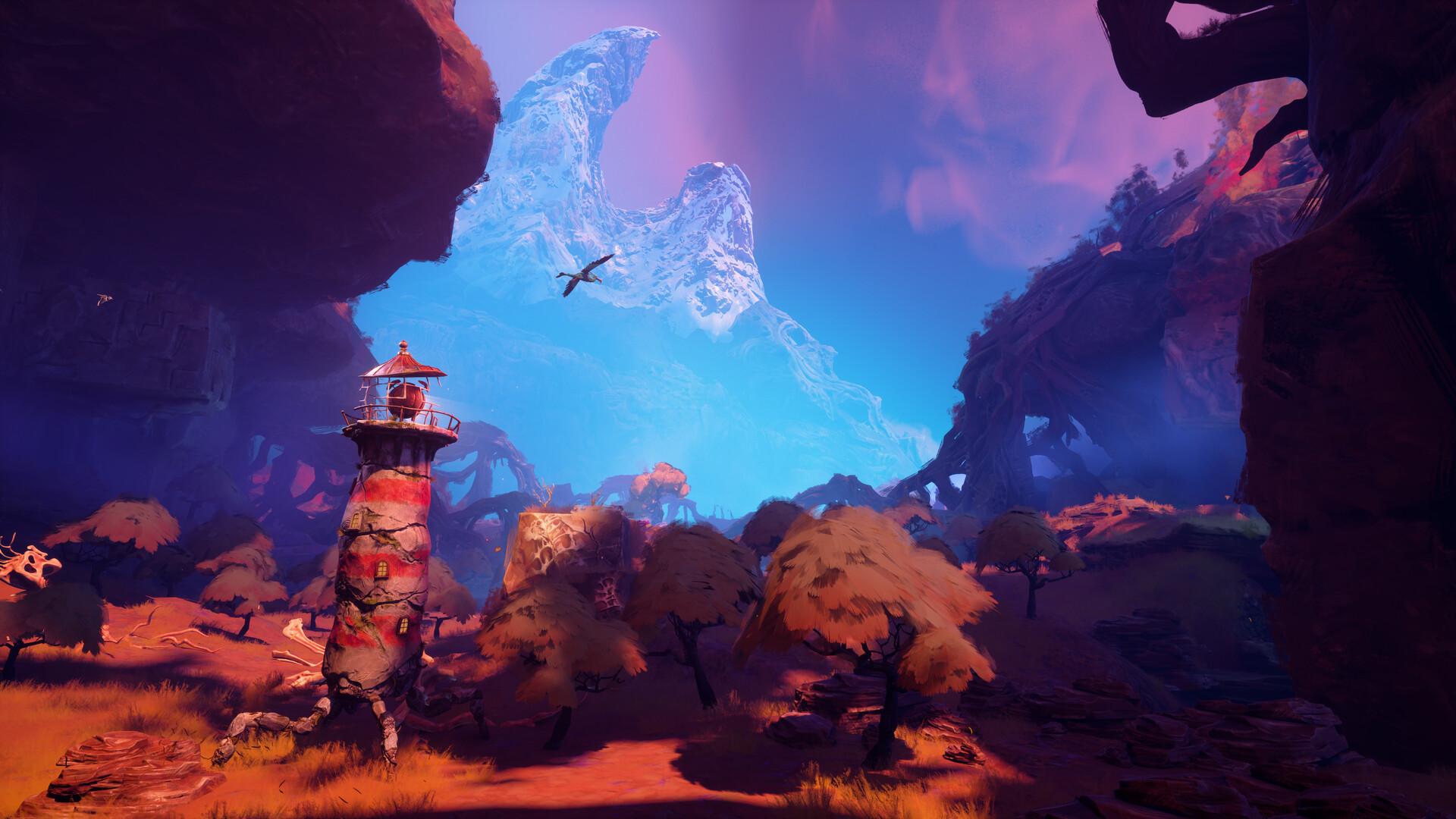
I’ve always been a fan of Double Fine. While not every game they make is a winner, that’s because they’re willing to take big risks and experiment. When Microsoft acquired them, many worried they’d be pressured to make more predictable games, and their first release under Microsoft, Psychonauts 2, seemed to confirm those fears – it was their most conventional game to date.
Good news for those worried Double Fine had lost its touch – Keeper proves they can still create wonderfully strange games! You take on the role of the Keeper, a living lighthouse whose beam of light pushes back against a spreading darkness. When a charming little bird-like fish lands on your head, you embark on a journey to the top of a distant mountain, determined to save the world from this corruption.
The game instantly makes you feel like the lighthouse has a personality. Its art style is a wonderful mix of realistic detail and cartoonish charm. You can clearly see the wear and tear—every crack and imperfection—but it’s also playful, even giving the lighthouse expressive metal ‘eyebrows’ above its light.
The story unfolds through visuals and actions, not through spoken words, and it’s incredibly effective. You fully understand everything without a single line of dialogue. The new Keeper spends the first few minutes clumsily learning to walk, which is both charming and slightly disturbing. This happens while you walk through a graveyard filled with the remains of previous Keepers who didn’t survive.

What really gets me about Keeper is how it balances fun and sadness so well. One minute you’re in this bright, colorful, and quirky world, and the next you feel this real sense of pressure and gloom. It’s not just about the bad stuff happening either – sometimes the world itself feels dangerous as you’re trying to solve the puzzles and climb the mountain. It’s a really clever way to keep you on edge!
The game excels at guiding you through its world, introducing new puzzles, exploring them thoroughly, and then seamlessly transitioning to the next thing. This keeps the three-hour experience moving at a brisk and enjoyable pace, preventing you from getting stuck on any single concept for too long, whether it’s visually or in terms of gameplay.
The puzzles aren’t overly challenging, but they’re cleverly designed with creative concepts that make them more than just simple problem-solving. A standout section involves manipulating time, which creates interesting puzzles where you alter the surrounding environment. What really makes it special is how this is presented. For example, traveling back in time causes your bird companion to revert to an egg, while moving forward shows them fading into bones and becoming a ghost – until you return to the present.
The game isn’t limited to a single style of play, which was a pleasant surprise. It starts as a lighthouse-based experience, then unexpectedly shifts to a seafaring adventure with lots of puzzles. Finally, it ends with a fast-paced, action-packed sequence reminiscent of Sonic the Hedgehog – but I won’t spoil that part, you’ll have to play it to see what it’s like!

The game consistently introduces surprising new ideas that completely alter how you play. One moment you’re moving slowly as a lighthouse, the next you’re speeding along as a boat, or even rolling at incredible speed. It quickly cycles through these unique concepts, offering a lot of variety without overstaying its welcome.
While the game is generally good, the camera could use some improvement. It usually points you in the right direction, but it can unexpectedly swing around to face the opposite way, which is frustrating. Finding hidden lore and backtracking are also made difficult by the camera, as it doesn’t always cooperate. This is especially noticeable later in the game when you’re moving faster and need to turn around quickly.
Sometimes, I found myself a little lost trying to figure out what I could actually do with the environment. It didn’t happen a ton, but there were a few times where the game told me to shine my light on something, and I honestly had no clue what it wanted me to look at! The world is gorgeous and really colorful, which is awesome, but it also meant that important things didn’t always pop out when they needed to.
Double Fine has always been known for quirky, imaginative games with a few rough edges, and Keeper is no exception. It builds a really charming and visually appealing world, telling a heartwarming story about an unexpected friendship and a quest to save the day. Because of this, any small annoyances are easily overlooked when you look at the overall experience. Double Fine, keep doing what you do!
More reviews on DBLTAP:
Read More
- Silver Rate Forecast
- Красный Октябрь акции прогноз. Цена KROT
- Gold Rate Forecast
- Nvidia vs AMD: The AI Dividend Duel of 2026
- Dogecoin’s Big Yawn: Musk’s X Money Launch Leaves Market Unimpressed 🐕💸
- Bitcoin’s Ballet: Will the Bull Pirouette or Stumble? 💃🐂
- Navitas: A Director’s Exit and the Market’s Musing
- LINK’s Tumble: A Tale of Woe, Wraiths, and Wrapped Assets 🌉💸
- Can the Stock Market Defy Logic and Achieve a Third Consecutive 20% Gain?
- Solana Spot Trading Unleashed: dYdX’s Wild Ride in the US!
2025-10-31 15:17